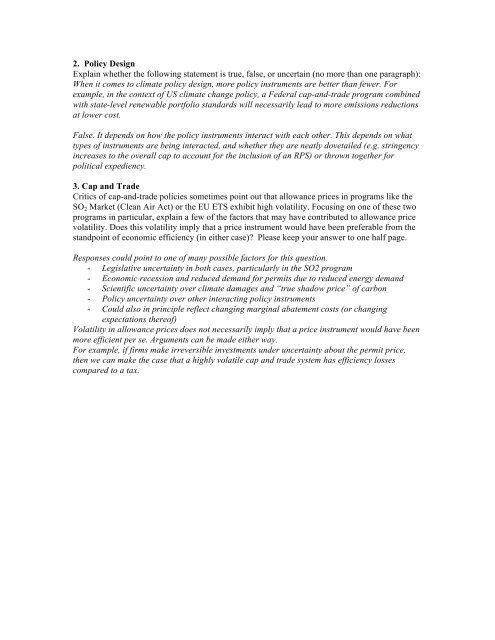Problem Set 5 - with solutions - iSites - Harvard University
Problem Set 5 - with solutions - iSites - Harvard University
Problem Set 5 - with solutions - iSites - Harvard University
You also want an ePaper? Increase the reach of your titles
YUMPU automatically turns print PDFs into web optimized ePapers that Google loves.
2. Policy Design<br />
Explain whether the following statement is true, false, or uncertain (no more than one paragraph):<br />
When it comes to climate policy design, more policy instruments are better than fewer. For<br />
example, in the context of US climate change policy, a Federal cap-and-trade program combined<br />
<strong>with</strong> state-level renewable portfolio standards will necessarily lead to more emissions reductions<br />
at lower cost.<br />
False. It depends on how the policy instruments interact <strong>with</strong> each other. This depends on what<br />
types of instruments are being interacted, and whether they are neatly dovetailed (e.g. stringency<br />
increases to the overall cap to account for the inclusion of an RPS) or thrown together for<br />
political expediency.<br />
3. Cap and Trade<br />
Critics of cap-and-trade policies sometimes point out that allowance prices in programs like the<br />
SO 2 Market (Clean Air Act) or the EU ETS exhibit high volatility. Focusing on one of these two<br />
programs in particular, explain a few of the factors that may have contributed to allowance price<br />
volatility. Does this volatility imply that a price instrument would have been preferable from the<br />
standpoint of economic efficiency (in either case)? Please keep your answer to one half page.<br />
Responses could point to one of many possible factors for this question.<br />
- Legislative uncertainty in both cases, particularly in the SO2 program<br />
- Economic recession and reduced demand for permits due to reduced energy demand<br />
- Scientific uncertainty over climate damages and “true shadow price” of carbon<br />
- Policy uncertainty over other interacting policy instruments<br />
- Could also in principle reflect changing marginal abatement costs (or changing<br />
expectations thereof)<br />
Volatility in allowance prices does not necessarily imply that a price instrument would have been<br />
more efficient per se. Arguments can be made either way.<br />
For example, if firms make irreversible investments under uncertainty about the permit price,<br />
then we can make the case that a highly volatile cap and trade system has efficiency losses<br />
compared to a tax.
















